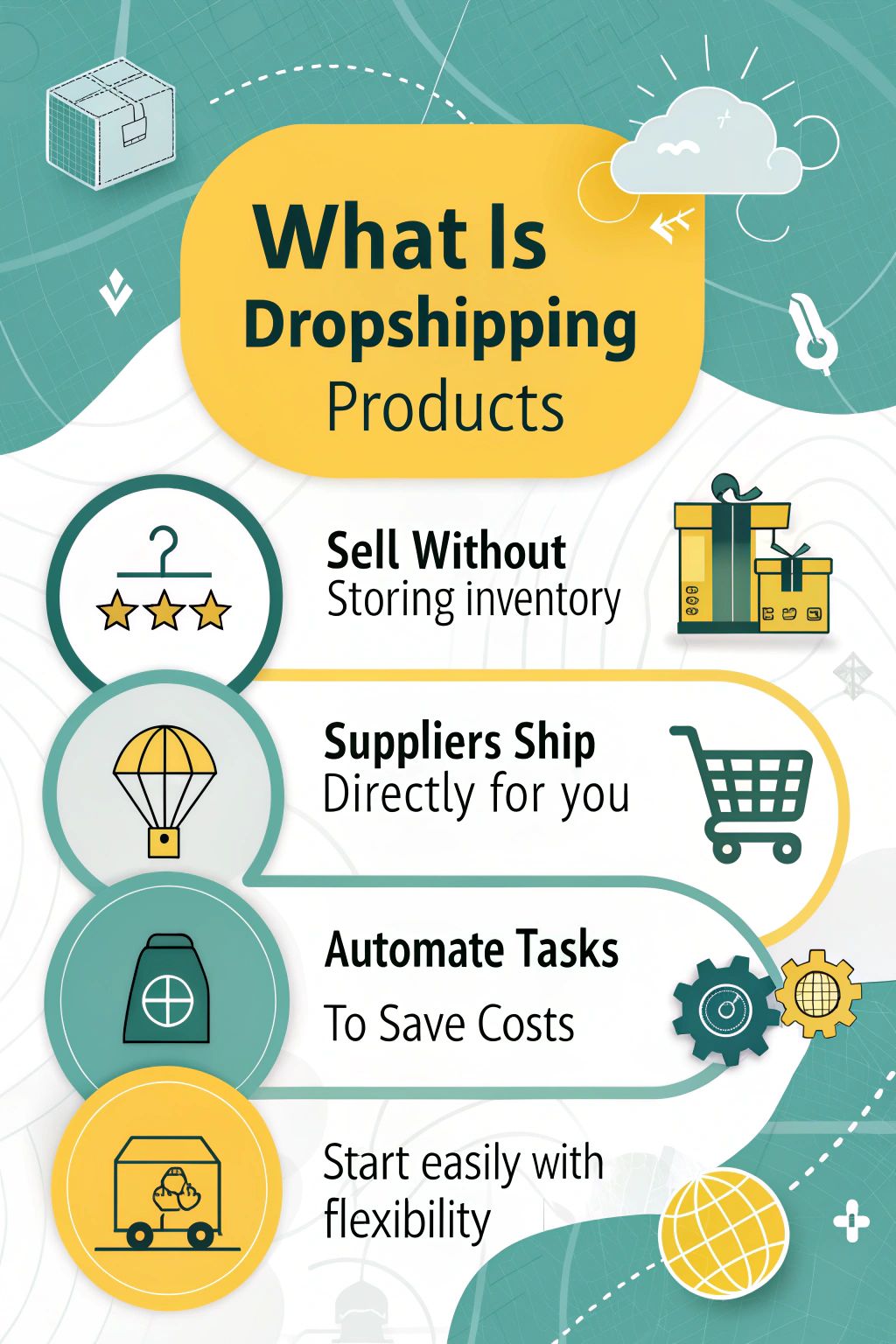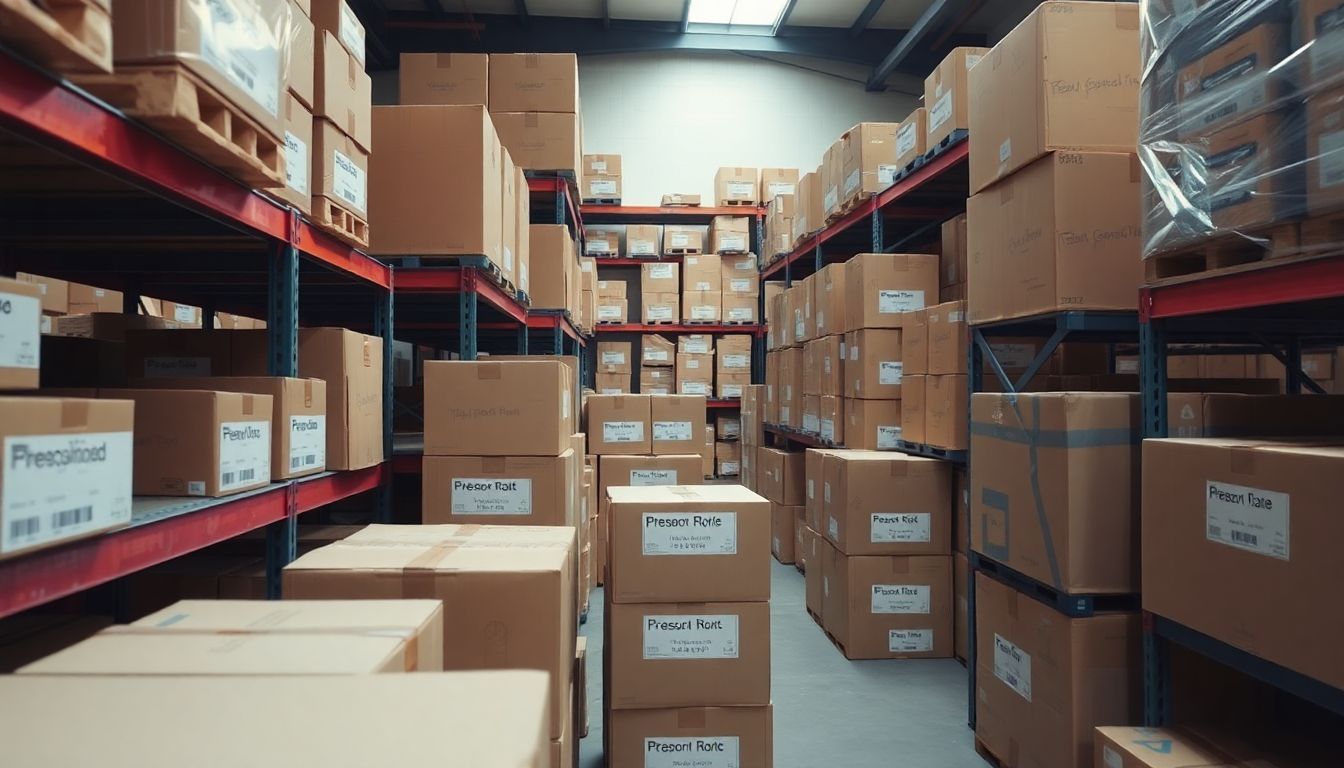Starting an online store sounds exciting, but storing products and managing inventory can feel overwhelming. Many new sellers struggle with upfront costs and the hassle of keeping stock.
It’s hard to balance time, money, and effort when just starting.
Dropshipping offers a simple way to sell without holding inventory. Sellers connect with suppliers who ship products directly to customers. This means less stress over storage or shipping logistics.
In this blog, readers will learn how dropshipping works, its perks and downsides, and steps to start their own business. Ready to explore more? Keep reading!
Key Takeaways
- Dropshipping lets sellers run a store without keeping inventory. Suppliers ship products directly to customers.
- Platforms like SmokeDrop offer over 20,000 smoke products for dropshipping with no minimum order limits.
- Sellers save on costs by skipping storage and automating tasks like inventory syncing and order fulfillment.
- Challenges include low profit margins, quality control issues, and potential shipping delays from suppliers.
- Tools like Shopify or WooCommerce make starting a dropshipping business simple and flexible for beginners.

What Is Dropshipping?

Dropshipping is a way to sell products without keeping them in stock. A store takes customer orders, and a supplier ships the items directly to the buyer.
[What is Dropshipping for Beginners](https://thesmokedrop.com/what-is-dropshipping-for-beginners/)
Dropshipping means selling products without keeping them in stock. The retailer lists items online, and once a customer orders, the supplier ships the product directly to them. This method skips inventory storage, making it easier for new businesses to start.
Platforms like SmokeDrop simplify this process. They offer over 20,000 smoke products ready for dropshipping. Retailers can sync their stores with apps like Shopify or WooCommerce, import products quickly, and manage orders smoothly.
With fast shipping and automated systems, dropshippers save time while offering competitive prices to attract buyers.
How Does Dropshipping Work?
Dropshipping works through a simple process where the store sells products without keeping them in stock—suppliers handle storage and shipping directly to customers. Keep reading to learn how it all fits together!
Key players in the dropshipping model
Retailers, suppliers, and customers drive the dropshipping model. Retailers sell products online without keeping inventory. Suppliers store goods and handle order fulfillment. Customers place orders through retailers’ websites.
SmokeDrop simplifies this process for retailers. It offers over 20,000 smoke products for dropshipping with no minimum order requirement. It integrates with platforms like Shopify, WooCommerce, and BigCommerce for effortless setup.
Automated inventory sync ensures smooth operations every step of the way.
Steps involved in the dropshipping process
Dropshipping is a simple way to sell products online without keeping them in stock. Here are the steps involved in the dropshipping process:
- Choose a niche for your store. Focus on popular items like smoke products or accessories to attract customers easily.
- Find reliable suppliers. Use platforms like Shopify, WooCommerce, or BigCommerce to connect with trusted wholesale providers.
- Import products to your online store. Select items using advanced search filters and upload them quickly with just a few clicks.
- Set up pricing and inventory management tools. Use automation features to track stock levels and adjust prices if needed.
- List items on your store for sale. Ensure product descriptions are clear so customers know what they’re buying.
- Receive customer orders through your website’s platform integration.
- Forward orders to the supplier automatically or manually for processing using automated systems.
- The supplier packages and ships the product directly to the buyer, saving you storage space.
- Track shipments by managing tracking numbers provided by suppliers.
- Provide excellent support by handling any issues related to shipping delays or returns efficiently.
This process makes order fulfillment quick and smooth while reducing overhead costs! Now, let’s look at how this business model benefits new sellers in “Pros of Dropshipping.”
Pros of Dropshipping
Dropshipping makes starting an online store easy and affordable. Keep reading to see why it’s a popular choice!
Low initial investment
Retailers spend less upfront since they don’t need to buy inventory in advance. SmokeDrop’s platform lets sellers test products with minimal financial risk. The wholesale options allow purchases without minimum order limits.
This flexibility helps retailers try new items without large commitments.
Sellers save time and money by easily importing products into their stores. Automated order fulfillment reduces costs and cuts down manual work. These features lower the risks of starting a business, especially for beginners looking to explore dropshipping opportunities.
Next comes avoiding inventory storage hassles!
No need for inventory storage
Dropshipping removes the hassle of storing products. Stores using SmokeDrop can access over 20,000 smoke shop items without keeping stock. This saves space and cuts costs for business owners.
Order fulfillment is automated too, making it easier to manage sales. Product importation tools help sync inventory fast, so sellers avoid stock headaches. No minimum order rules also allow more flexibility in product choices.
Flexible business operations
Ecommerce stores with dropshipping enjoy great flexibility. Retailers can import products into their store quickly. Platforms like Shopify and WooCommerce make setup easy for sellers.
No minimum order rules let them adjust orders based on demand without hassle.
Automated tools improve inventory management and order processing. Inventory syncing ensures smooth operations while saving time. Search filters help find the right product fast, boosting efficiency in online retail.
This adaptability supports growth without extra stress or costs.
Next, learn about some downsides of dropshipping businesses…
Cons of Dropshipping
Dropshipping has its challenges that can make it tricky for beginners. Some issues may surprise you and require careful planning to handle.
Low profit margins
Low profit margins are a common issue in dropshipping. Retailers compete heavily, which often forces prices down, cutting into profits. Fulfillment costs like fast shipping can also add up and further reduce earnings.
Automated processes might save time but may lead to smaller returns overall.
An extensive product range doesn’t always mean great sales. Some items won’t bring high profits, making it harder to manage costs effectively. Careful control of inventory and fulfillment is crucial to avoid losing money on certain products.
Next comes the challenge of quality control in dropshipping businesses.
Limited control over product quality
Relying on third-party suppliers often means less control over product quality. Retailers cannot inspect smoke products or accessories before they reach customers. This lack of oversight can lead to differences in product standards, hurting customer satisfaction.
Product consistency depends heavily on supplier reliability. Poor-quality items damage brand reputation and trust. Dropshippers must carefully vet suppliers to reduce these risks. Choosing the right dropshipping platform also helps manage quality control issues effectively.
Potential supply chain issues
Limited control over product quality often ties to supply chain problems. Delays in shipping can upset customers waiting for their orders. Suppliers may run out of stock, leaving you unable to fulfill purchases on time.
Order fulfillment mistakes or poor communication with suppliers can lead to wrong items being sent. Long delivery times might hurt customer satisfaction and build-up refund requests.
Supply chain disruptions also make return processing harder, frustrating both sellers and buyers alike.
How to Start a Dropshipping Business
Starting a dropshipping business needs careful planning and choices. Picking the right products and tools makes all the difference for success.
Market research and niche selection
Market research helps find what customers want. It shows demand and trends in different markets. Choosing a niche narrows focus to a specific group of buyers. For example, SmokeDrop offers over 20,000 smoke products for retailers targeting this market.
A diverse catalog attracts many types of customers while meeting unique needs.
Niche selection increases sales by targeting one group well. Picking the right niche requires studying trends and customer behavior. Tools like SmokeDrop make it easy with no minimum orders for wholesale purchasing and fast product imports.
They also sync inventory with ecommerce platforms, simplifying management for online stores in niche markets.
Choosing the right platform for your store
Pick a platform with easy tools for dropshipping products. SmokeDrop connects with platforms like Shopify, WooCommerce, and BigCommerce to make selling simple. It supports automated order fulfillment and syncs orders straight to suppliers.
Use advanced search filters to find specific items fast. With SmokeDrop, retailers can import products quickly without hassle. Wholesale purchasing has no minimum order requirement, giving stores more flexibility in managing inventory needs.
Finding reliable dropshipping suppliers
Reliable dropshipping suppliers play a big role in business success. SmokeDrop offers over 20,000 smoke shop products, making it an easy choice for retailers. They have no minimum order requirements, so sellers can start small without risk.
Popular brands are included, giving stores variety and appeal.
Automated tools from SmokeDrop help manage orders and sync inventory with Shopify, WooCommerce, or BigCommerce. These integrations save time and keep things organized. Retailers can even request a free demo to see how the platform boosts revenue quickly.
Now, focus on your store’s platform choice to streamline processes further!
Costs and Profitability of Dropshipping
Running a dropshipping business involves costs like products, marketing, and fees—but smart planning can help boost profits.
Common expenses in dropshipping
Dropshipping has specific costs. Store owners pay for access to a wide product range. For example, over 20,000 smoke shop items may be available. Automated order processing helps reduce operational costs.
These systems also sync inventory with ease.
No need for warehouses means lower overhead costs. Platforms like Shopify or WooCommerce make store integration simple and cost-effective. Wholesale purchasing allows for flexible expenses—there are no minimum order requirements! Return costs stay low with fast shipping options, keeping customer satisfaction high.
Next: Learn how to calculate profit margins in dropshipping…
How to calculate profit margins
To calculate profit margins, subtract all costs from your total revenue. Include expenses like product cost, shipping fees, and platform charges. Then divide the remaining amount by the total revenue to get your profit margin ratio as a percentage.
For example, if you sell an item for $50 but spend $30 on costs, your gross profit is $20. Divide $20 by $50 to get 0.4 or 40%. This helps you measure how much of each sale is actual profit.
Alternatives to Dropshipping
There are other ways to run an online store that don’t rely on dropshipping—each has its own perks and challenges.
Fulfillment by Amazon (FBA)
Fulfillment by Amazon (FBA) helps sellers handle storage, shipping, and customer service. Sellers send their products to Amazon’s warehouses. Then, Amazon takes care of packing and delivery once an order is placed.
This option saves time on inventory management and shipping tasks. FBA also improves delivery speed with access to Amazon Prime benefits. While it offers convenience, fees can cut into profits for smaller businesses or low-margin items.
Affiliate marketing as a business model
Unlike FBA, affiliate marketing does not require storing or shipping products. It works through commission-based marketing. Businesses reward affiliates for driving sales or leads to their site.
Affiliates promote products using referral links on blogs, social media, or videos.
This model offers flexibility and low costs since no inventory is needed. Performance-based marketing means affiliates only earn once a sale happens, making it risk-free for companies.
Many join affiliate programs from networks like Amazon Associates or PartnerStack to expand income streams.
Creating your own private-label products
Selling private-label products gives dropshippers more control. These are items branded with a store’s name or logo, like house brands in grocery stores. Sellers pick generic goods from suppliers and add their unique labels.
This creates “exclusive label products” that stand out from competitors.
Private brand products also build loyalty. Customers often trust own-brand products over unbranded ones. Dropshippers can choose from skincare, electronics, or fashion items–there’s plenty to customize! By offering branded products, sellers can charge higher prices and earn better profit margins too.
Is Dropshipping Right for You?
Dropshipping isn’t for everyone. Think about your goals, time, and resources before jumping in.
Evaluating your goals and resources
Check your product catalog. SmokeDrop offers over 20,000 items. Match these to your business needs. Focus on what sells well in the smoke product market.
Think about shipping times and profit margins. Fast delivery boosts customer satisfaction. Use SmokeDrop’s automated order process for smooth operations and growth. Check platform integration options like Shopify or WooCommerce to make selling easier.
Managing customer service and returns
Fast order processing makes customer service easier. Automated order fulfillment reduces time spent fixing mistakes. Tracking updates keep buyers informed and happy. Stores can manage orders, tracking numbers, and inventory all in one place.
Dropshippers don’t need to worry about unsold inventory piling up. Wholesale purchasing without minimums simplifies returns for unused stock. Product import tools also reduce errors in orders or returns.
E-commerce integration keeps everything smooth from start to finish.
Next, consider if dropshipping matches your goals and resources…
Conclusion
Dropshipping is a simple way to start an online store. It requires low upfront costs and no need for storage. This model lets sellers focus on growing their business while suppliers handle shipping.
Though challenges like slim profit margins exist, the potential is big with smart planning. Tools and platforms, like SmokeDrop, make managing orders easier and faster. Anyone can explore dropshipping as a flexible option in eCommerce—small steps can lead to big results!
FAQs
1. What is dropshipping?
Dropshipping is a way to sell products online without keeping them in stock. You take orders from customers, and your supplier ships the items directly to them.
2. How does dropshipping work?
You set up an online store and list products for sale. When someone buys something, you forward their order to a supplier who handles shipping.
3. Do I need a warehouse for dropshipping?
No, you don’t need one! The beauty of dropshipping is that suppliers store the products, so you never handle inventory.
4. Is dropshipping easy to start?
Yes, it’s simple—no big upfront costs or storage needed! But it takes time and effort to find good suppliers and market your store effectively.




